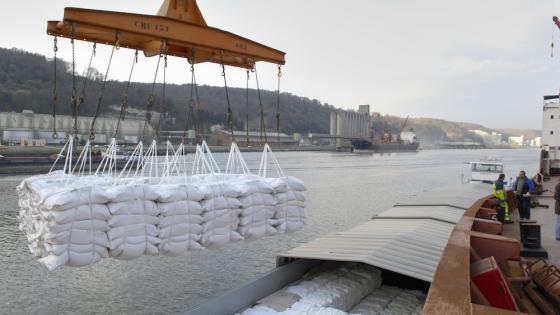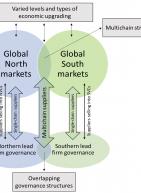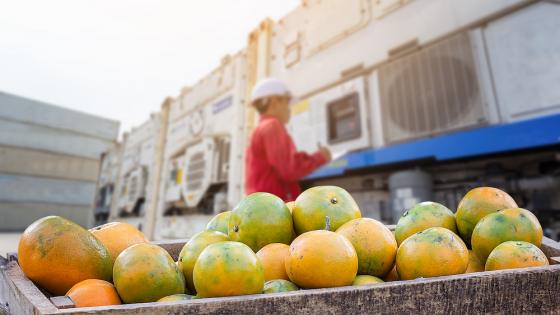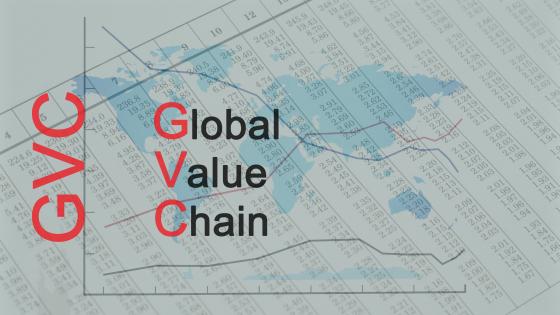Today, the food we eat is increasingly delivered by global production systems that cross multiple borders. Wheat harvested in Argentina and Ukraine, for example, is processed into flour in Kazakhstan and Turkey, and then exported to make pasta in Italy and instant noodles in China in order to feed people across the world. Trade in agriculture and food has more than doubled in real terms since the early 1990s. Emerging and developing countries have become active participants in global markets, and they now account for about one-third of global agricultural trade. Technological advancements have made it possible to transform production and trade processes, which have in turn enabled the emergence of global value chains in agriculture and food.
Participation in agri-food global value chains (AGVCs) has been at the centre of much recent development policy debate in low-income countries, especially in sub-Saharan Africa and South Asia, where the agriculture sector is the main source of livelihoods, accounting for more than 15% of GDP (World Bank 2019, Zimmermann et al. 2020, Zhan et al. 2020, Antimiani and Cernat 2021, Pasquali et al. 2021). But few studies have explored how participation in AGVCs influences the national economic outcomes of modern agrarian economies. This column summarises my 2021 investigation of how globalised agri-food value chains affect structural transformation (Lim 2021).
The geography of agri-food global value chains
AGVCs have grown rapidly since the mid-1900s. From the 1950s to the 1980s, agricultural industries were in a period of pre-globalisation, shifting from traditional, small-scale, and informal to larger-scale and more formal. Since the early 1990s, when trade liberalisation expanded with China’s emergence as a major participant in world trade, countries have modernised their agricultural GVCs (Reardon et al. 2009). Through rapid vertical integration, leading global grocery processors and retailers have emerged as dominant players in AGVCs by linking farmers upstream with customers downstream (Sexton 2013).
Using the EORA Multi-Region Input-Output Tables (MRIOs) for 155 countries in the period 1991−2015 (generated by the UNCTAD-Eora Global Value Chain Database in Borin and Mancini 2019), I find primary stylised facts about AGVCs. Across countries, the mean total AGVC participation was 31.7%, with agricultural GVC participation (33.2%) slightly larger than food GVC participation (30.9%). Total AGVC participation is almost equally distributed downstream (15.67%) and upstream (16.09%). However, AGVC participation in agriculture and food industries is not as equally distributed. In agriculture, upstream participation (22.29%) is approximately twice as great as downstream participation (10.91%); in the food industry, downstream participation (19.28%) is 1.6 times greater than upstream participation (11.62%). In other words, GVCs in food and beverages likely have a larger share of backward linkages in production and relatively fewer forward linkages because the food and beverage industry involves a higher degree of foreign value-added – including processing, distributing, and labelling. The different patterns of average GVC participation in the agriculture and food industries are robust across years in the period 1991−2015.
I also look at the pattern of AGVC participation by income level. First, high-income countries’ total AGVC participation (37.12%) is about 20% greater than that of lower-income countries. Also, as countries’ incomes rise, their downstream participation increases and upstream participation decreases. Finally, relatively low-income countries participate more in the upstream agriculture industry than relatively high-income countries, while in the downstream food industry the reverse is true.
Figure 1 Agri-food GVC participation across countries in 2015
Notes: GVC participation rates in 2015. Panels (a) and (b) display GVC participation rate across countries in the agriculture sector and the food and beverages sector, respectively
Figure 1 shows the world map of AGVC participation in the year 2015. European countries and sub-Saharan African (SSA) countries show a relatively high level of GVC participation in both the agriculture and food industries. Also, European countries are more involved in downstream participation (backward linkages), while African countries are more involved in upstream participation (forward linkages) (see Figure 2). This AGVC participation pattern is likely to be driven by increasing demand from Europe for raw commodities produced in SSA in order to produce more processed food in Europe (Balié et al. 2019).
Figure 2 Agricultural GVC participation by region, 1991–2015
Notes: For individual regions, I use the UN Standard Country Codes for Statistical Use (Series M, No. 49), a standard for area codes used by the United Nations for statistical purposes. Africa (Northern African, sub-Saharan Africa); Americas (Northern America, Latin America and the Caribbean); Asia (Eastern Asia, Southern Asia, South-eastern Asia, Central Asia, Western Asia); Europe (Southern Europe, Eastern Europe including Northern Asia, Western Europe). Oceania (four countries) is excluded from the analysis.
How agri-food GVCs can transform agrarian economies
Since Kuznets and Murphy (1966) wrote about structural transformation – wherein a country reorients its economic activities from the agricultural sector toward the manufacturing and services sectors – their argument has received a lot of attention in policy debates surrounding economic growth in both developed and developing countries. Although the rise of GVCs has changed modern agricultural production systems, whether and how the rise of AGVCs has affected the economic structure of participating countries is still not settled (Barrett et al. 2019). One scenario is that countries allocate more economic resources to the agricultural sector from the non-agricultural sector because more AGVC participation might increase agrarian export volume by adding value in supply chains. A second scenario is that countries reallocate economic resources from the agricultural sector to non-agricultural sectors such as manufacturing or services. This scenario is often supported by the view that some countries outsource agricultural production from other countries and focus more on food processing and labelling in downstream value chains. Using data on 155 countries over the period 1991−2015, I look specifically at whether participation in AGVCs changes the GDP and employment shares of the agricultural, manufacturing, and services sectors.
First, I find that countries participating in AGVCs tend to become more agrarian on average. Both GDP share and employment share in the agricultural sector are positively associated with an increase in AGVC participation. However, individual countries also tend to become less industrial and more services-based. Both GDP and employment shares in manufacturing decrease as the country increases its participation in AGVCs, while in the services sector more participation in AGVCs is positively and significantly associated with an increase in the GDP share and the employment share. These findings suggest that modern agrarian economies are leapfrogging the manufacturing sector to directly develop their services sector through greater participation in AGVCs. This result runs counter to the conventional wisdom about structural transformation − a sequential development process by the agricultural, manufacturing, and services sector over time.
Second, I find that the core results of structural transformation appear to be driven by high-income countries. Outside of the high-income category, the findings seem to be highly dependent on the type of country considered. For example, employment shares in low-income and lower-middle-income countries in particular seem to follow the conventional structural transformation narrative.
Finally, I further analyse whether positioning in AGVCs matters for structural transformation. After decomposing the total AGVC participation into upstream participation and downstream participation in AGVCs, I find that the core leapfrogging result remains robust both upstream and downstream. However, when GDP shares are the outcomes under consideration, upstream participation in AGVCs is associated with a more agrarian economy; when employment shares are the outcomes, downstream participation in AGVCs is associated with a more agrarian economy. This finding implies that upstream participation leads to more labour-intensive agriculture, and downstream participation leads to more capital-intensive agriculture.
Policy conclusions
The findings in this column can help inform agricultural trade policy in two ways. First, policymakers may wish to focus on participation in global agricultural production if their goal is to transform their economies by reallocating resources across sectors. In debates about Brexit, the redesign of the North American Free Trade Agreement (NAFTA), and the recent trade war between the US and China, trade policies are focused more on protecting domestic agriculture from agricultural imports. This perspective seems to reflect a tacit expectation that GVC linkages alter the conventional calculus of trade protection. The results suggest that trade liberalisation through agricultural GVCs can lead to structural transformation in the same way that a country can reallocate its economic resources in non-agricultural sectors, which has been seen as a main driver of economic growth.
Second, although it may be tempting for governments to foster participation in GVCs with an eye toward structural transformation, policymakers should be cautious when trying to open up their agricultural markets. The results here suggest that a country is able to transition its economy out of agriculture through its participation in GVCs by producing intermediate inputs related to manufacturing and services but not in the agriculture sector. Since many poor developing countries have a competitive advantage in agriculture rather than in manufacturing or service, they may be tempted to join agricultural GVCs by allocating more agricultural resources to intermediate production for export. Although doing so might result in higher overall GDP or employment, it is unlikely to transform an economy into one primarily based on manufacturing and services. Trade policies should therefore be designed to improve manufacturing or services-related domestic activities in intermediate agricultural production.
References
Antimiani, A and L Cernat (2021), “GVCs for LDCs: A multilateral initiative to boost trade along global supply chains for least developed countries”, VoxEU.org, 24 June.
Balié, J, D Del Prete, E Magrini, P Montalbano and Silvia Nenci (2019), “Does trade policy impact food and agriculture global value chain participation of Sub-Saharan African countries?”, American Journal of Agricultural Economics, 101(3): 773–789.
Barrett, C, T Reardon, J Swinnen and D Zilberman (2019), “Structural transformation and economic development: insights from the agri-food value chain revolution”, Mimeo, Cornell University.
Borin, A and M Mancini (2019), Measuring what matters in global value chains and value-added trade, The World Bank.
Koopman, R, Z Wang and S-J Wei (2014), “Tracing value-added and double counting in gross exports”, American Economic Review, 104(2): 459–94.
Kuznets, S and J T Murphy (1966), Modern Economic Growth: Rate, Structure, and Spread, Vol. 2, New Haven: Yale University Press.
Lim, S (2021), “Global Agricultural Value Chains and Structural Transformation”, National Bureau of Economic Research.
Pasquali, G, A Krishnan and M Alford (2021), “When trade shifts South: New upgrading prospects for horticulture suppliers in the Global South”, VoxEU.org, 01 July.
Reardon, T, C B Barrett, J A Berdegué and J FM Swinnen (2009), “Agrifood industry transformation and small farmers in developing countries”, World Development, 37(11): 1717–1727.
Sexton, R J (2013), “Market power, misconceptions, and modern agricultural markets”, American Journal of Agricultural Economics, 95(2): 209–219.
World Bank (2019), World development report 2020: Trading for development in the age of global value chains.
Zhan, J, R Bolwijn, B Casella and A U Santos-Paulino (2020), “Global value chain transformation to 2030: Overall direction and policy implications”, VoxEU.org 13 August.
Zimmermann, A, C Baldin, E Dervisholli, E Koroleva, H Attaallah, G Rapsomanikis, and R Dellink (2020), “The State of Agricultural Commodity Markets 2020: Agricultural Markets and Sustainable Development”, The State of Agricultural Commodity Markets 2020.





